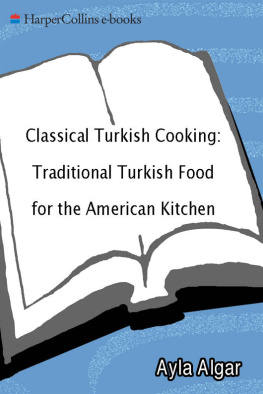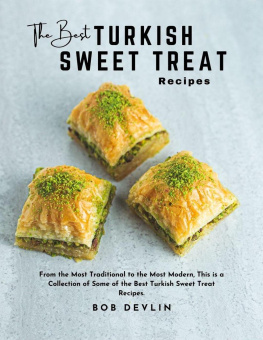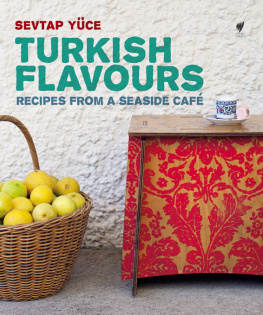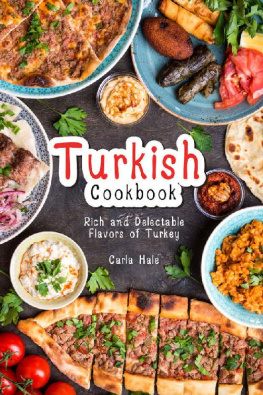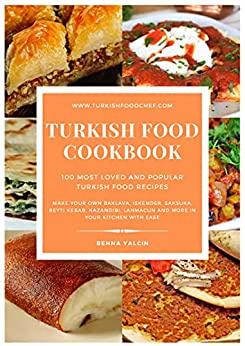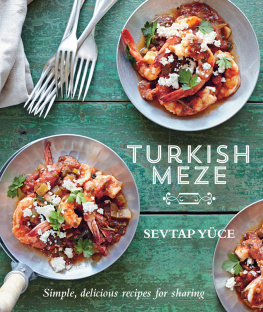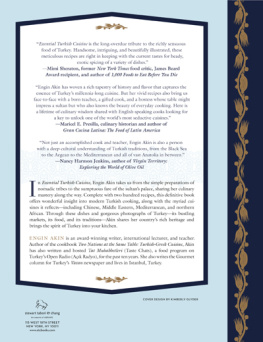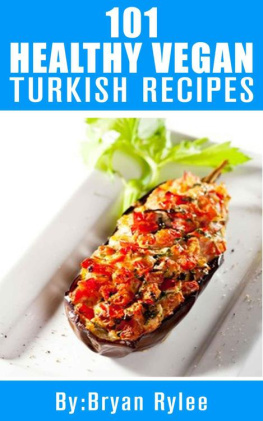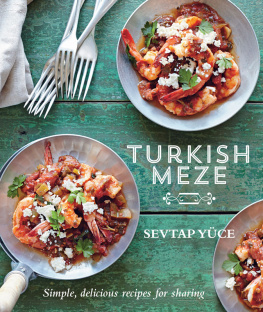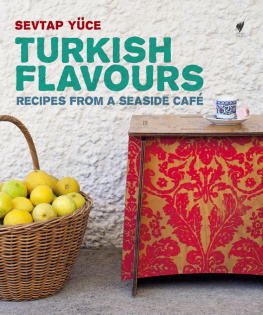

To Hamid and my sons, Dennis, James, Larry, and Selim
CONTENTS

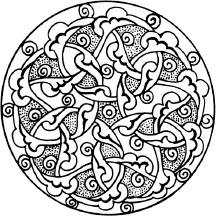

M y gratitude goes first to the hard-working women of my country who devote themselves utterly to their families, keeping homes where the sweet smell of cooking provides constant reassurance and a source of strength. It is in this spirit that I think affectionately of my grandmother, mother, and aunts, whose cooking has nourished me, body and soul, and left me with many precious memories.
I am forever grateful to my husband for all his varied help, without which this book could never have been written.
Among the scholars who have written on Turkish and Middle Eastern food and food history, I feel particularly indebted to Alan Davidson, perhaps the first Westerner to take a serious interest in Turkish cuisine; Charles Perry, whose diligent researches have clarified many an obscure point of etymology and food history; and the Kuts, Gnay and Turgut, scholars of literary history who have not disdained the study of Ottoman culinary texts.
I express my heartfelt gratitude to Glsen Kahraman of the Turkish Ministry of Culture and Tourism who kindly provided much needed help in gaining access to restaurants and bakeries. My appreciation goes also to Kamil Toygar of the same ministry for his generous assistance in finding books relating to food history.
I carry a particularly heavy debt of gratitude to the staff of numerous restaurants and bakeries in Turkey. Special thanks go to owner Nurettin Doanbey, pastry chef Abdullah Akku and baklava chef Abdulbaki Yazgah of Konyah Restaurant; Beyti Gler of the Beyti Restaurant; Hristo obanolu and chef Ismail Demir of Pandeli Restaurant; the director and kitchen staff of Kalyon Hotel; chef Sleyman zgen of the Divan Oteli; Abdurrahman Seer and all the bakers at the simit bakery in Tahtakaleall in Istanbuland the bakers at the Dou bakery in Ankara, especially Omer Asian and Haci oban.
I thank my young friend Hatice Aynur of the University of the Bosphorus for promptly obtaining for me the urgently needed photocopy of the nineteenth-century classic cookbook of Mehmet Kamil.
Thanks, too, and fond good wishes to my dear friends, Mine Mengi, Trkan Ersin, and Glumay Ozbay, for all their help and suggestions.
I am indebted to my agent, Susan Lescher, for her generous encouragement and her faith in this book. Heartfelt thanks to Susan Friedland, senior editor at HarperCollins, for her patient, diligent, and persistent work on the book. Finally, I am very grateful to my friend Florence Myer for typing an immaculate manuscript, in conformity with her usual high standards.

L ike all major culinary traditions, that of Turkey is marked simultaneously by unity and diversity. The unity derives ultimately from the traditions of the Ottoman palace, which, filtering down to the population at large in modified form, became the foundation for a common national cuisine. This classic cuisine has always been cultivated in its fullest form in Istanbul, and from there conveyed to the provinces through family ties or other linkages with that great metropolis.
The assimilation of the food of Istanbul by the provinces has, however, been subject to significant regional variations. Local tastes as well as availability of ingredients have often dictated the use of certain foods in preference to others. Thus the meat dolmas of Gaziantep in southeastern Turkey tend to be spicier than elsewhere because of their heavier use of cumin, peppers, and garlic, while the yogurt soups of eastern Anatolia substitute sweet basil for mint and wheat for rice. In the Aegean area there is a tendency to cook everything in olive oileven baklava, in violation of the national consensus that it should be cooked in butter. Furthermore, the popularity of certain dishes is uneven throughout the country. Olive oil dishes, for example, are rare in central and eastern Anatolia, areas with a strong preference for meat dishes, and are cooked mostly by those with an Istanbul background. In addition to these regional variations on Istanbul cuisine, fully distinct regional traditions of great richness and antiquity also exist. Collectively, these might be designated as Anatolian cuisine, for they owe nothing to the cuisine of Istanbul, although they are to be found side by side with it. Anatolian cuisine deserves separate and detailed treatment; we will concentrate in this book on the cuisine shared by the whole country, offering only a few glimpses of regional specialties.
My richest source of recipes and food lore has been my family in Turkey; many of the dishes included here evoke strong personal memories. Since for professional reasons my father traveled widely across Turkey, I had the good fortune to stay in various parts of Anatolia and learn something of their distinctive culinary traditions. This exposed me to a variety of tastes and helped me to appreciate the relationship between the classic cuisine and its regional variants. In more recent years I have benefited from the expertise of numerous chefs and bakers kind enough to take me into their kitchens.
Through extensive reading and research I have also studied all the available Turkish cookbooks, including those published in the nineteenth century in the Ottoman script, as well as a wide range of sourceslexicons, poetry, historical texts, memoirs, books by European travelersthat serve to illuminate the historical and cultural background of Turkish food.

Turkish History in the Mirror of Food
One should not pass over these things, simply saying they are food. They are in reality a complete civilization.
Abdlhak inasi, amlcadaki Enitemiz (1944)
T he task of the culinary historian is in many ways akin to that of the archeologist. Both must work with fragmentary materials, scrutinizing them for indications of origin in place and time, and correlating their sometimes scanty evidence with linguistic, literary, and historical data. But just as the skillful archeologist conjures up a lost civilization from what appears to the layman as unpromising scraps of evidence, the historian is able to turn the commonplace subject of food into a mirror that reflects the history and culture of a nation with remarkably little distortion. The ingredients, dishes, and cooking techniques of a cuisine, together with the names used to designate them, all offer abundant clues to the historical growth of a nation, its religious loyalties and cultural affinities, its changing economic fortunes, and the general interplay of change and continuity within its life. As Margaret Visser has recently written, echoing Byron, Much depends on dinner.
The archeological concept of strata may also be applied to certain major cuisines that can be seen to have traversed fairly distinct stages of evolution, successively superimposed on each other as the edifice of taste and consumption gradually attains definitive form. Thus in Turkish cuisine one can discern Far Eastern, Central Asian, Iranian, Anatolian, and Mediterranean layers, each of them mirroring one stage in the long and complex history of migration that has enabled the Turks both to exert and to receive influence all across Eurasia.
Next page
